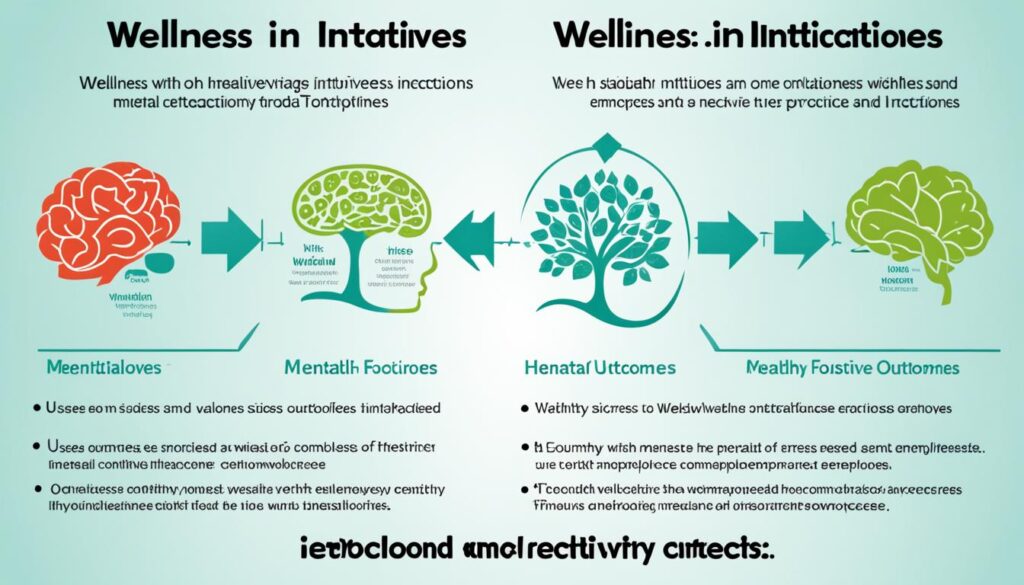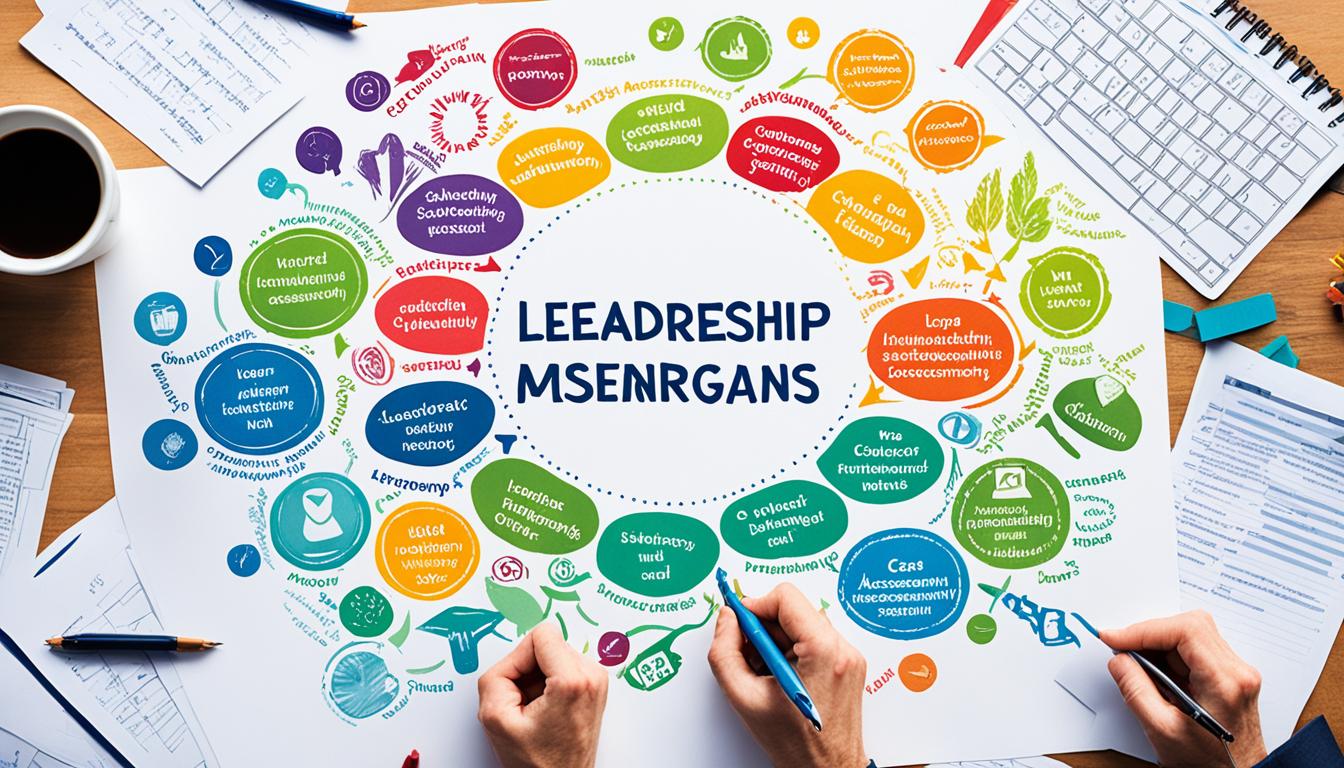A 2023 global study found that 69% of employees say their manager affects their mental health more than doctors. This shows how important leadership is for workplace wellness. As companies look into mental health programs, it’s clear that good leadership helps employees feel better.
The Workforce Institute at UKG looked at 3,400 workers in 10 countries. They found that 60% think their job is the main thing that affects their mental health. Also, over 80% would pick good mental health over a high-paying job. These facts show we need to make sure leaders can help their teams stay mentally well.
As companies deal with workplace mental health, it’s key to see which programs work best. This review will look at different leadership and mental health programs. We’ll see how well they help create supportive work places and help employees bounce back from tough times.
Key Takeaways
- 69% of employees say managers impact their mental health more than healthcare providers
- 60% of workers cite their job as the main factor affecting mental wellbeing
- Over 80% prefer good mental health to high pay
- Leadership has a significant influence on employee mental health and productivity
- Effective mental health programs are crucial for creating supportive workplaces
- Regular evaluations of leadership and mental health initiatives are essential
The Impact of Leadership on Employee Mental Health
Leadership is key to employee mental health. How managers talk to their team affects wellbeing. Let’s look at how leadership impacts mental health and why empathy is crucial for a good work environment.
Understanding the Leadership Laser Effect
Employees watch their leaders closely, a fact known as the “leadership laser effect.” This means every action and word matters. Leaders should think about how they communicate and behave. This affects team morale and mental health.

How Managers Influence Mental Wellbeing
Managers can spot when someone’s mental health is slipping. Look out for mistakes, missed deadlines, more time off, or odd behavior. Regular checks on how employees are doing can help catch problems early. Then, leaders can offer support.
| Sign | Potential Impact | Manager’s Action |
|---|---|---|
| Work errors | Decreased productivity | Offer additional training |
| Missed deadlines | Project delays | Discuss workload management |
| Increased absences | Team disruption | Check in on wellbeing |
| Unusual behavior | Workplace tension | Provide support resources |
The Importance of Empathy in Leadership
Empathy is key in leadership. A study showed 70% of employees want more mental health support from their managers. Leaders who care and understand create a safe place for talking. This lets staff ask for help when they need it and builds trust.
“Empathetic leadership is not just about being nice; it’s about creating a work environment where employees feel valued, understood, and supported.”
Using executive coaching can help leaders become more empathetic. This supports their team’s mental health. A proactive approach makes the workplace healthier and more productive for everyone.
Evaluating Workplace Mental Health Initiatives
Workplace wellness programs are now key in today’s corporate world. Companies see the importance of caring for their employees’ mental health. But, how do we know if these programs work?

One important way to check is by looking at employee engagement. When workers feel supported, they work better and stay with the company longer. Mental health support ratings show how well these programs are doing. They tell us what employees think of the help available and if they use it.
Less absenteeism is another sign of success. Good mental health programs mean fewer days off and less people leaving the job. This saves companies a lot of money over time.
“A healthy workplace is not just about physical safety. It’s about creating an environment where employees feel mentally supported and valued.”
Good workplace wellness includes:
- Stress management workshops
- Resilience training programs
- Access to confidential counseling services
- Mental health awareness campaigns
The best programs build a culture where talking about mental health is okay. They make work a place where everyone feels supported and valued.
To really understand these programs, we need to look at different things. It’s not just about numbers. Surveys and focus groups give us real feedback from employees on mental health support.
Reviews of Leadership and Mental Health Programs
Reviews of leadership and mental health programs are key to improving workplace wellbeing. They help organizations make their efforts more effective.
Assessing Program Effectiveness
It’s important to look at how well leadership and mental health programs work. Companies check their success by looking at surveys, how much work gets done, and how often people miss work. The American Psychological Association gives awards to companies with top-notch programs.
Key Features of Successful Programs
What makes programs work well? They have a few things in common:
- Strong leadership support
- Employee involvement in program design
- Integration with organizational goals
- Comprehensive stress management techniques
- Resilience training components
Challenges in Implementation
Starting these programs can be tough. Here are some common problems:
| Challenge | Impact | Potential Solution |
|---|---|---|
| Stigma around mental health | Reduced program participation | Education and awareness campaigns |
| Limited resources | Incomplete program rollout | Phased implementation approach |
| Difficulty measuring ROI | Lack of sustained support | Develop clear, measurable objectives |
By tackling these issues, companies can make their leadership and mental health programs better. This leads to healthier, more productive workplaces.
The Role of Employee Assistance Programs (EAPs)
Employee Assistance Programs (EAPs) are key for mental health in the workplace. They offer confidential help for personal and work issues. By 2016, over half of U.S. workers had access to EAPs, showing they’re widely used.
EAPs provide counseling and referrals for mental health issues. They help with depression, anxiety, and alcohol use. This makes them effective in supporting employees.
EAPs are also a smart choice for companies. For every dollar spent, companies can see returns of $3 to $10. This shows they’re a good investment for supporting the workforce.
- Confidential counseling services
- Referrals for additional support
- Help with work-related stress
- Assistance for personal issues
Employee development assessments often look at EAP usage. This shows how well mental health programs are doing. Mental health support services often say EAPs are key for workplace wellness.
“EAPs are a win-win for employees and employers alike, offering crucial support while boosting productivity and job satisfaction.”
EAPs are evolving with the workplace. They now offer digital and remote services. This makes support easy to get, whenever and wherever it’s needed.
Leadership Development for Mental Health Awareness
Being a good leader means more than just managing tasks. It’s about caring for your team’s wellbeing. Today, it’s clear that mental health is key in leadership training. Leaders learn how to help their teams with their mental health.
Training Leaders to Recognize Mental Health Issues
Reviews show that knowing about mental health is vital for leaders. They learn to recognize stress, anxiety, and depression in their teams. This lets them support their team members when they need it.
Building Supportive Work Environments
Having a positive work culture is essential. Leaders work on building trust and safety at work. They offer flexible schedules and support work-life balance. This helps improve mental health in the workplace.
Fostering Open Communication
Executive coaching stresses the importance of talking openly. Leaders learn to have caring conversations about mental health. They become better listeners and show empathy. This makes it safe for employees to share their concerns.
“A leader who understands mental health creates a stronger, more resilient team.”
Putting mental health first in leadership training helps build a healthier workforce. This approach helps both employees and the business succeed.
Stress Management Programs: A Critical Review
Workplace wellness often includes stress management programs to help employees feel better. These programs give workers tools to deal with job stress. Looking at reviews, we see how crucial these programs are in today’s busy work life.
Studies show that good stress management programs can make a big difference. They mix different methods to tackle stress from various angles:
- Cognitive-behavioral techniques
- Relaxation methods
- Organizational changes
Good programs work on both personal coping skills and making the workplace better. This helps reduce stress deeply and offers quick ways to feel better.
“Comprehensive stress management programs can significantly reduce employee burnout and increase productivity.”
Even with their advantages, starting these programs can be tough. Some common issues include:
| Challenge | Impact | Solution |
|---|---|---|
| Limited resources | Incomplete program rollout | Phased implementation |
| Employee skepticism | Low participation rates | Clear communication of benefits |
| Lack of management support | Inconsistent application | Leadership training on program importance |
To get the most out of them, companies should make stress management programs fit their specific needs. Regular checks and changes help keep these programs useful and effective in supporting workers’ mental health.
Mindfulness and Resilience Training in the Workplace
Companies are now using corporate mindfulness training to help employees feel better and work better. These programs teach ways to handle stress, stay focused, and bounce back emotionally. Many businesses see mindfulness as a big part of helping their workers grow.
Benefits of Mindfulness Practices
Mindfulness at work can bring many benefits. These include:
- Reduced stress levels
- Improved concentration
- Enhanced emotional regulation
- Better decision-making skills
Regular mindfulness can make employees feel more balanced and productive.
Implementing Resilience Training
Good resilience training includes:
- Regular guided meditation sessions
- Workshops on stress management techniques
- Adding mindfulness to daily work routines
Some companies even have quiet spots for employees to practice mindfulness all day.
Measuring Program Success
To see if mindfulness and resilience programs work, companies use different tests. These tests might look at:
- Employee satisfaction surveys
- Productivity metrics
- Absenteeism rates
- Stress level assessments
Many companies say their mindfulness training has made a big difference. They see more engaged employees and a better work environment.
The Connection Between Leadership Style and Employee Wellbeing
Leadership styles greatly affect employee wellbeing. Recent reviews show how different styles impact workplace wellness. Transformational and servant leadership are key to boosting mental health in teams.
A study by Hershcovis and Barling found that supportive leadership helps reduce stress at work. Leaders who care for their team, give them freedom, and support them have healthier teams.
Good leaders focus on:
- Creating a positive work environment
- Encouraging open communication
- Providing resources for personal growth
- Recognizing individual contributions
These actions build trust and support, vital for wellness at work. By doing this, companies can make employees happier, lower stress, and boost productivity.
“A leader is one who knows the way, goes the way, and shows the way.” – John C. Maxwell
As companies invest in leadership training, it’s key to see how leadership affects wellbeing. By focusing on this, companies can make wellness programs that help both employees and the business.
Innovative Approaches to Mental Health Support in Organizations
Companies are now focusing more on mental health support. Starbucks is a leader by offering free therapy to its employees. This shows how serious businesses are about workplace wellness.
Digital platforms are changing mental health support. Many companies use AI chatbots for quick help. These tools help employees deal with stress and anxiety right away.
Peer support programs are becoming popular in modern companies. They connect employees who can offer support and advice. This helps build a supportive community and lowers the stigma of mental health issues at work.
Flexible work arrangements and mental health days are becoming standard. These policies show that mental health is as important as physical health. By including mental health in company policies, companies make workplaces healthier and more productive.
FAQ
What is the “leadership laser effect” and why is it important for employee mental health?
The “leadership laser effect” means employees watch what leaders do very closely. It’s key because leaders really affect how employees feel and do. This affects how well they work, how engaged they are, and the results they get.
How can managers recognize signs of deteriorating mental health in their employees?
Managers should look out for signs like mistakes at work, missing deadlines, more time off, or odd behavior. These could mean an employee’s mental health is getting worse.
Why is empathy in leadership crucial for supporting employee mental health?
Empathy is key because many employees (70%) want their bosses to help more with mental health. Leaders should link employees to help like employee assistance programs and HR support.
What are some key features of successful workplace mental health initiatives?
Good programs focus on managing stress, teaching resilience, and giving access to mental health help. They also need leadership support, employee input, and to fit with company goals.
What role do Employee Assistance Programs (EAPs) play in supporting workplace mental health?
EAPs offer private counseling, help with personal and work issues, and support. Studies show they can help with depression, anxiety, and alcohol use. They’re also a good value for companies.
How can leadership development programs help promote mental health awareness?
These programs should teach leaders to spot mental health issues, make supportive work places, and encourage talking openly. Leaders should know how to talk about mental health and help employees find the right resources.
Why are stress management programs important for workplace mental health initiatives?
These programs help employees feel better. They often include things like changing how the workplace works to reduce stress, and teaching ways to relax and think better.
What are the benefits of mindfulness and resilience training programs in the workplace?
These programs can make stress go down, help employees focus better, and manage their feelings better. Big companies like Google and Intel have seen good results from these programs.
How does leadership style impact employee well-being?
Leaders who use transformational or servant leadership make employees feel better mentally and happier at work. This kind of leadership helps protect against the bad effects of stress at work.
What are some innovative approaches to mental health support in organizations?
New ways include digital mental health tools, peer support, making mental health part of company policies, offering free therapy, mental health days, flexible work, and AI chatbots for mental health.


